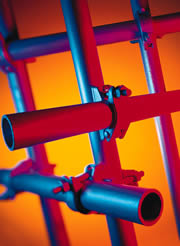Researchers have developed a tiny, self-built structure. They hope that it will help repair damaged spinal cords.
Helen R. Pilcher, Nature (translation: Dikla Oren)

These may be the smallest scaffolds in the world and the easiest to assemble. Researchers have developed a tiny, self-built structure. They hope that it will help repair damaged spinal cords.
Every year in the USA alone about 15,000 people are injured in the spine. Few recover completely, as it is difficult for the goblet cells to bridge the gap in damaged spinal cords.
Researchers tried to build bridges over these gaps and thus allow the nerves to grow. Most of these bridges are made of solid materials such as collagen and therefore required invasive surgery, which may increase the trauma to the affected area.
Samuel Stepp and his colleagues from Northwestern University, Chicago, on the other hand, found a way to build the bridge from a liquid material.
When the solution is injected into a rodent's damaged common cord, it turns into a gel-like solid, Stapp says. The scaffold is designed to degrade after four to six weeks and hopefully leave behind a healthy spinal cord.
The liquid is made of negatively charged molecules. There is usually an electrical repulsion between them, and the substance remains in a liquid state. However, when the liquid meets positively charged molecules, such as the calcium and sodium ions found in living tissues, the molecules cluster together. "The clustering happens almost immediately," Steph says.
The molecules are designed to group together in a certain way, so that they form a structure of tiny hollow tubes. Each tube is approximately 5 nanometers wide - a width 10,000 times smaller than the width of a human hair - and a few hundred nanometers long. The structure is porous and allows nerve cells to grow through and around it.
The team also attached to each molecule in the liquid a small section of protein, which the nerves can recognize and cling to. The addition of the protein may help the development and growth of nerve cells, Steph speculates.
It's a sophisticated system, says David Mooney, who studies tissue engineering at the University of Michigan. The system allows control of the physical and biological construction process of the building.
However, many difficulties must be overcome. Even with the help of the chemical scaffolds, the nerve cells may still refuse to regrow.
After a spinal cord injury, the surrounding cells form a thick scar, explains spinal cord researcher Elizabeth Bradbury of King's College London. Neurons cannot pass through this impenetrable barrier. It may be necessary to add enzymes to the system, which break down this scar, she adds.
To improve the chance of repairing the spinal cord the team also tried to add new nerve cells to the system. When embryonic cells, cells that can differentiate into other specific cells, such as nerve cells, were added to the solution, they became neurons and began to grow on the solid bridge. The team plans to do the same in injured rodent spinal cords.
